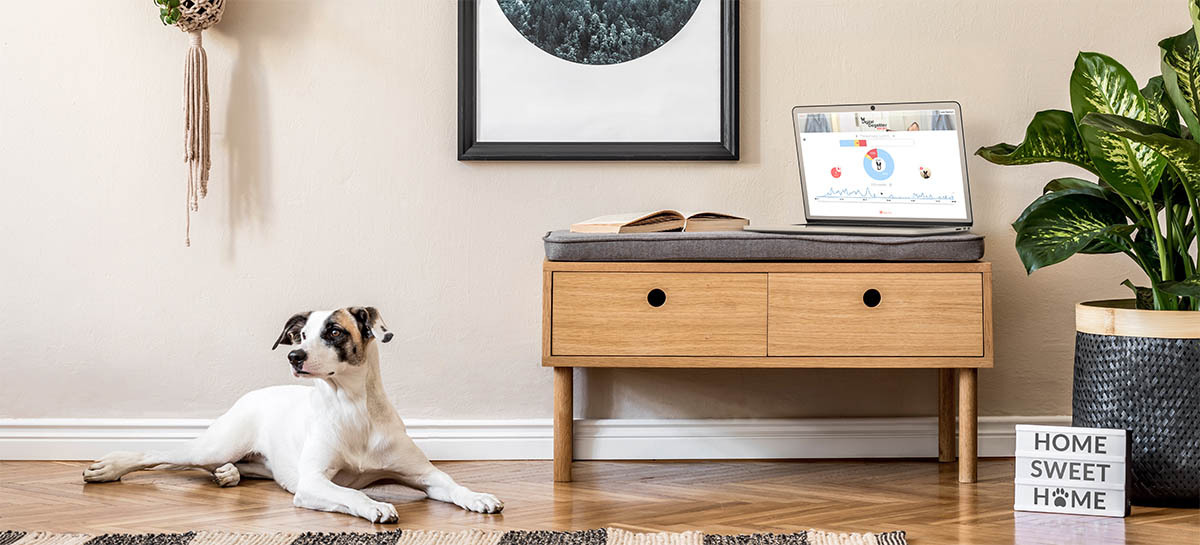Living with a dog's separation anxiety is always a limiting factor in the dog owner's life, which is why it's worth implementing all means that can ease the situation to support separation anxiety training. To help with the treatment of separation anxiety, various medications have been developed, aimed at smoothing the training process and enabling everyday life with relaxed alone time as soon as possible.

There are both short-acting and long-acting medications used to treat separation anxiety. Long-acting medications are mood-altering drugs that affect the function of pleasure hormones, such as selective serotonin reuptake inhibitors or MAO inhibitors. The purpose of these medications is to increase the activity of pleasure hormones in the body through various mechanisms, which can increase the dog's tolerance for things that typically cause stress. Long-acting mood medications are given to the dog daily, and their full effect is achieved about 3 weeks after starting the medication. Short-acting medications, on the other hand, are sedatives, or calming medications, which are administered to the dog as needed. The medication can be given, for example, two hours before the intended alone time. The typical duration of effect for a short-acting medication is 2-4 hours, depending on the dog. It's important to note that the dog's individual condition, such as the nervous system's stress state and intestinal health, affect the success and dosage of both long-acting and short-acting medications.
Choosing the Medication
The primary consideration in choosing medication is consultation with a veterinarian, as well as making a reliable assessment of the dog's behavior, for example, with the help of a trainer. The medication should be suitable for the specific dog being treated. The effects of the medication should be closely monitored for side effects and to continuously assess the benefits received. The medication should be appropriate for the quality of the dog's behavior and meet a genuine need, as medication does not work as a quick fix or in a situation where it is not truly suitable. All medications have potential side effects, and their risk increases when the medication is chosen on weaker grounds. For example, if the dog needs more appropriate stimuli in its daily life and more meaningful exercise, exhibiting symptoms of unfulfilled needs during alone time, medication may do more harm than good. The intestines of a dog with gastrointestinal disease may find the medication too harsh, and their health condition may deteriorate. The dog's health condition should always be confirmed before starting any medication. The use of medications also involves regular blood test controls.
Mood Medication for Dogs
Research has shown that long-acting mood medications do not affect the dog's ability to be alone without systematic desensitization. The opportunities for quality training are in a key position when planning the use of mood medication. Mood medications can have an overall relaxing effect on the dog, so the dog's behavior may change in areas other than just being alone. Common side effects of mood medications, depending on the preparation, are the dog's fatigue and loss of appetite. In some dogs, the symptoms subside within a few weeks, but some have to switch preparations. For some dogs, no medication is found that works appropriately with sufficiently few side effects.
Sedative Medication for Dogs
Regarding short-acting medications, it should be noted that a sedative does not teach the dog new skills. A sedative may affect the behavior of a dog that has learned to do something or otherwise be restless when alone, but it cannot be used for desensitization-based training of separation anxiety. A short-acting medication affects the functioning of the nervous system, preventing the desensitization effect and thus the desired learning from occurring when dealing with a strong fear state and/or a genetic predisposition to separation anxiety. However, a dog suffering from something other than a strong fear state may gain positive experiences of being alone with the help of medication when feeling calm, so medication can be beneficial in certain situations. Short-acting medications can also be utilized when the dog experiences nervousness, for example, from being left in daycare, to avoid the adverse effects of separation situations on practicing being alone.
Very common side effects of sedative medications include excessive drowsiness and vomiting. If the dog feels nauseous, is exceptionally tired, or does not maintain its usual ability to function under medication, the medication should be discontinued. Before the next use, the dosage and/or suitability of the medication should be rechecked with a veterinarian. The dog should maintain its normal ability to function even under sedation. The purpose of the medication is to lower the intensity, sensitivity, and speed of the nervous system's reactions, but not to negatively affect the dog's ability to function.

Duration of Medication
Medication is used according to the veterinarian's instructions on a situational basis. For some dogs, brain chemical changes observable through careful monitoring over a long period can be considered, due to which the dog's life may be of higher quality with lifelong medication. If the dog's situation repeatedly deteriorates after the medication ends, even though the dog's well-being in everyday life and health has been fully considered, long-term medication may be a necessary option for the dog. Most dogs take medication for a shorter time, for example, for part of the training process or for a few months after successful alone times. It is individual whether the symptoms return when the medication ends and the dog's body gradually returns to its natural state.
Instructions related to the use of short-acting medications can be found in the package leaflet. Typically, short-acting medication can be used safely on consecutive days for about a week.
When Medicating a Dog Raises Concerns
Many dog owners have concerns about using medication. Everyone should consider their own feelings and knowledge about their dog, and familiarize themselves thoroughly with the medications before making a decision. Separation anxiety can be treated in various ways, and the medicinal method is just one of the options. For some dogs, medication is included in the training process at the owner's request only if training alone doesn't seem to be enough help and progress is slow or non-existent.
Fear of side effects is one of the most common reasons to avoid using medication. Very common side effects, i.e., those encountered in more than one in ten, are found in all medications. With short-acting medications, trying is easier because the effect ends more quickly. With long-acting medications, the trial usually lasts at least weeks. Medications do not have long-term or permanent side effects as a result of trying, unless the dog has, for example, an undiagnosed intestinal disease whose condition would worsen for some time from the medication trial. The biggest risks of using medication are related to other simultaneous medications and preparations: mood medications should not be used under any circumstances with other preparations related to serotonin metabolism, such as Zylkene, as the risk of serotonin syndrome increases. Also, some diseases, such as intestinal diseases, epilepsy, and liver problems, can have unpredictable interactions with medications, which is why taking a basic blood count and detailed discussion with a veterinarian is a significant part of choosing and implementing medication.
Medicating is also essentially related to the dog owner's ethical experience of medication. For one, it may feel natural to leave the dog sedated at home, while another may strongly feel it is the wrong solution for themselves and their dog. The essential thing is to find a solution that feels suitable for oneself and increases the dog's well-being.
Results with Medication
The use of mood medication should be considered when the dog's nervous system is in an overloaded state due to everyday life or, for example, long-term previous health concerns, and the dog's tolerance is not sufficient for training. In desensitization, the dog's nervous system is, as it were, carefully stretched to gradually endure more alone time. An overloaded dog can react repeatedly and without warning negatively to training, and its reactivity can cause gray hairs for the dog owner. Mood medication may possibly provide a calmer and more sustainable state for the overloaded dog, resulting in more working space for training as the dog's reactions are more moderate. Some mood medications are also used for pain management, in which case a pain patient can benefit from the medication for more reasons than just separation anxiety.
At best, successful medication affects the dog's brain chemistry and its real physiological challenges. It should be noted that a healthy, thriving dog typically does not need medication to support training if the dog does not have a history of long-term pain conditions, extremely strong fear states, or clearly abnormal behavior for the species. For example, mood medications are not typically used for puppy alone time training. Symptoms purely related to the dog's training and learning history are usually best treated without mood medication. When considering mood medication, one should always weigh in what kind of situations, for example, humans use mood medications and whether the dog's situation is such that medicating the pet feels ethical to oneself. One significant challenge with medications is precisely the ethical perspective: in what situations can an animal be given medications that it cannot refuse, and in what situations is it justified to think that the animal's behavior is clearly exceptional and not, for example, symptomatic of deficiencies in the living environment and well-being. By utilizing these reflections and carefully consulting a trainer and veterinarian, over-medication and burdensome medication trials are best avoided.
 Deutsch
Deutsch English
English Español
Español Français
Français Italiano
Italiano 日本語
日本語 Português
Português Suomi
Suomi Svenska
Svenska



